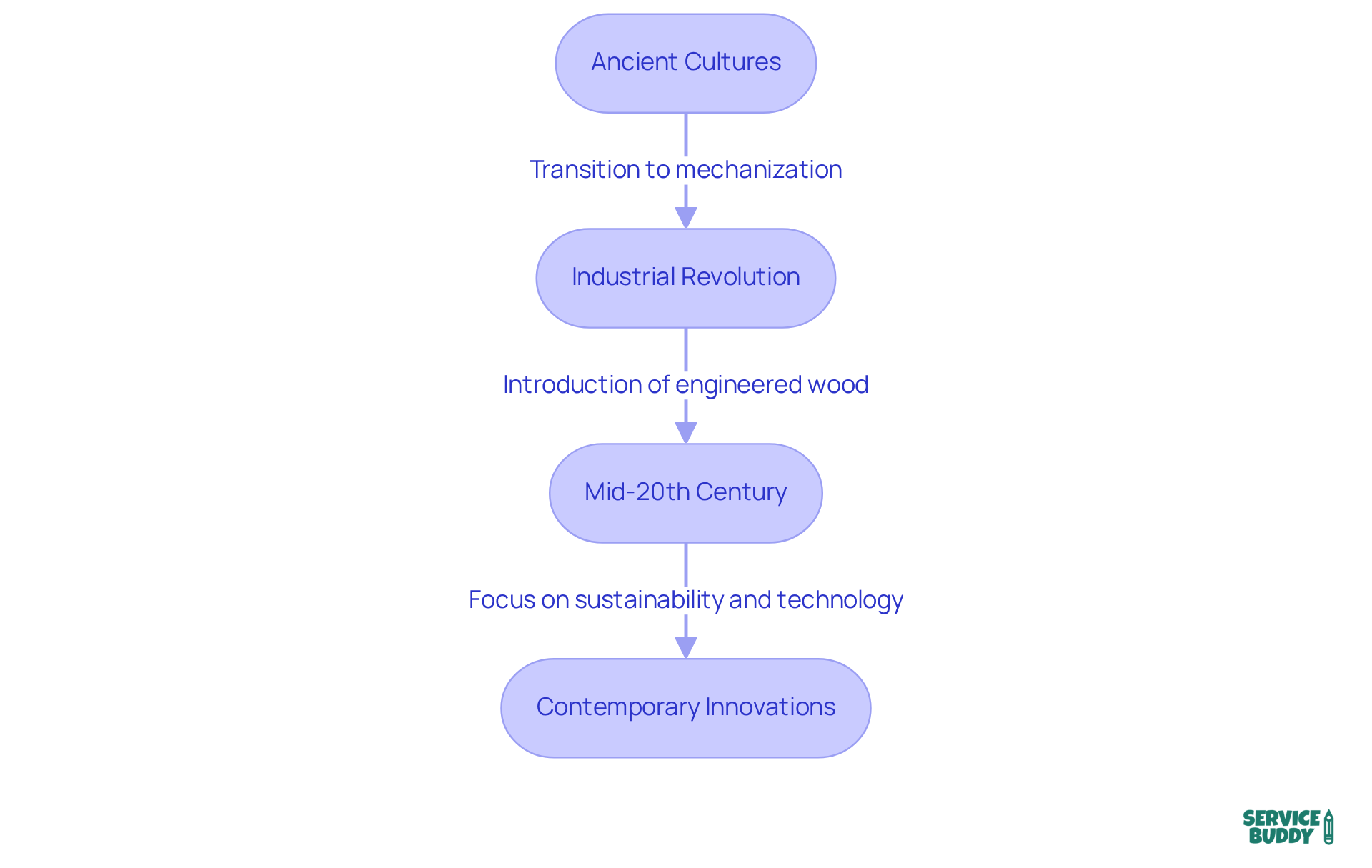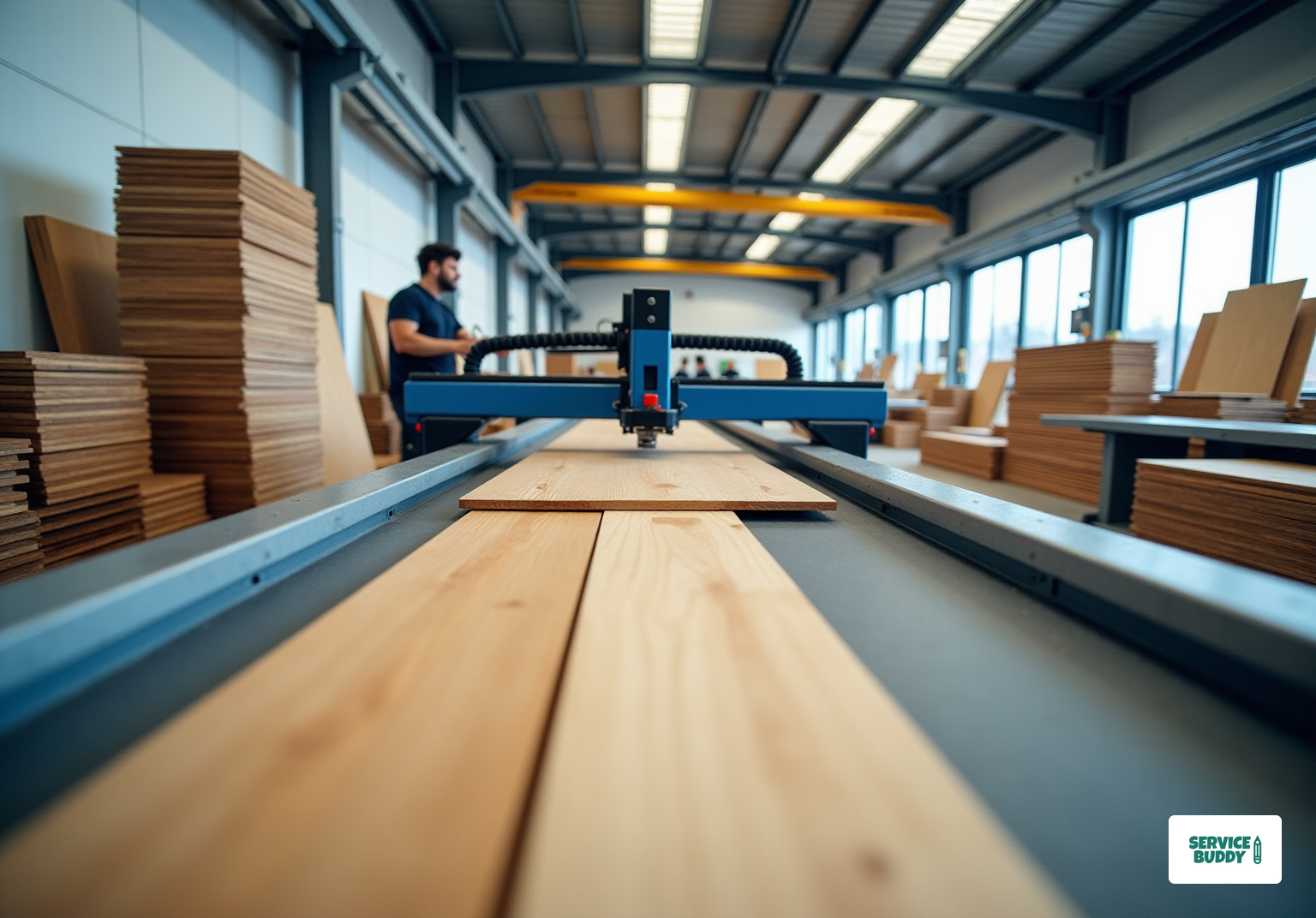Understanding Flooring Manufacture: Definition, Context, and Key Traits
Explore the complex world of flooring manufacture, covering trends, processes, and sustainability.

Introduction
The flooring manufacturing industry serves as a cornerstone of the construction and home enhancement markets, intertwining artistry with cutting-edge technology to create surfaces that are both functional and visually appealing. As consumer preferences shift towards sustainable and innovative materials, the demand for eco-friendly flooring solutions is surging. This rising trend prompts industry leaders to adapt their practices to meet these evolving needs.
However, as the market continues to evolve, a pressing question arises: how can manufacturers balance the need for durability and aesthetic appeal with the growing emphasis on sustainability? This article delves into the intricacies of flooring manufacturing, exploring its definition, historical evolution, and key characteristics that shape this dynamic industry. By understanding these elements, flooring business owners can navigate operational challenges and position themselves for success in an increasingly eco-conscious market.
Define Flooring Manufacture
The production of various kinds of surface coverings—hardwood, laminate, vinyl, and tile—is defined as floor covering manufacture. This intricate process encompasses the sourcing of raw components, the application of advanced manufacturing techniques, and the finishing processes that yield a product ready for installation. Flooring manufacture goes beyond simply creating a surface to walk on; it represents a complex interplay of design, engineering, and technology, customized to fulfill both aesthetic and functional requirements in residential and commercial spaces.
Recent trends reveal a significant shift in consumer preferences, with a surging demand for sustainable and visually appealing materials. The worldwide market for flooring products is projected to reach impressive figures by 2025, driven by increased construction activities and a focus on innovative designs. Key industry players, including Mohawk Industries and Shaw Industries, are adapting their production methods to integrate eco-friendly materials and advanced technologies, thereby enhancing their competitive edge.
The flooring manufacture process itself unfolds through several stages—design, engineering, and quality control—ensuring that each product adheres to stringent standards. Industry experts underscore the necessity of incorporating modern techniques, such as automated production lines and precision cutting, to bolster efficiency and minimize waste. As noted by a leading expert, "The evolution of surface manufacturing techniques is crucial for meeting the demands of a rapidly changing market."
In summary, surface production is not simply about creating coverings; it represents a sophisticated blend of artistry and technology that addresses the evolving needs of consumers and the market.

Contextualize Flooring Manufacture in the Industry
The flooring manufacture industry plays a crucial role in the construction and home enhancement markets, which are valued at USD 501.1 billion in 2025 and projected to reach USD 741.7 billion by 2035. As sustainability takes center stage, flooring manufacture is increasingly adopting eco-friendly materials and innovative technologies. This shift is fueled by rising consumer demand for durable and aesthetically pleasing options, coupled with regulatory pressures aimed at reducing environmental impact.
Notably, the adoption of eco-friendly flooring options, such as recycled and natural materials, is on the rise, reflecting a broader movement towards ethical flooring manufacture practices. The Non-Resilient Flooring segment, encompassing ceramic tiles and hardwood, is expected to dominate the market with a 36.2% share in 2025, largely attributable to its durability and low maintenance requirements.
Leading flooring manufacture companies like Mohawk Industries and Tarkett are spearheading this initiative, integrating sustainable practices into their production processes. For instance, Tarkett has introduced a carpet tile collection with the lowest circular carbon footprint, underscoring its commitment to sustainability. Their initiatives to reduce Volatile Organic Compounds (VOCs) and utilize recycled materials not only enhance product quality but also align with consumer preferences for environmentally friendly solutions.
As the industry evolves, the focus on sustainability in flooring manufacture is reshaping surface production, ensuring that products meet the diverse needs of both residential and commercial applications. This transformation presents flooring business owners with an opportunity to lead in sustainability while meeting the growing demand for eco-conscious solutions.

Trace the Evolution of Flooring Manufacture
The development of floor production can be traced back to ancient cultures, where natural substances such as stone and wood were utilized for surfaces. This historical foundation sets the stage for a significant transformation during the Industrial Revolution, which marked a turning point by introducing mechanized processes that enabled the mass production of materials for flooring manufacture.
As we progressed into the mid-20th century, innovations such as engineered wood surfaces emerged, providing a more affordable and stable alternative to solid wood. This shift not only catered to economic demands but also changed the landscape of flooring options available to consumers. In recent decades, advancements in technology have transformed flooring manufacture, leading to the creation of luxury vinyl planks and laminate surfaces that effectively imitate the look of natural materials while offering improved durability and ease of maintenance.
Today, the emphasis on sustainable practices is paramount, with producers actively exploring recycled materials and eco-friendly production techniques. A notable example of this commitment to innovation and sustainability can be seen in the renovation of the Duval County Court House in Jacksonville, where contemporary surfacing solutions have been seamlessly integrated into a large-scale project. Similarly, the successful tile installation at the Wind Creek Casino & Hotel underscores the importance of reliable resources and techniques, demonstrating how advancements in surface technology continually meet the evolving needs of modern construction endeavors.

Identify Key Characteristics of Flooring Manufacture
Key characteristics of flooring manufacture consist of durability, aesthetic appeal, ease of installation, and maintenance requirements. Durability is primarily influenced by the materials and manufacturing processes employed. Engineered hardwood and luxury vinyl are specifically designed to endure heavy foot traffic and resist wear. According to ThinkLab, a striking 65% of architecture and design experts cite durability as their primary selection criterion, underscoring its importance in consumer decisions.
Aesthetic appeal is crucial and is achieved through a variety of finishes, colors, and textures that cater to diverse design preferences. As highlighted by Brett Miller, VP of Technical Standards, Education, and Membership for NWFA, popular patterns such as parquet, herringbone, and chevron add flair to a room, significantly enhancing its visual impact.
Ease of installation is another essential aspect; many modern surface products are designed for DIY setup, which helps lower labor expenses. Maintenance requirements vary widely among surface types; while some may necessitate regular refinishing, others can be easily maintained with minimal effort. The trend towards low-maintenance surface solutions is particularly significant in 2025, as consumers increasingly seek options that simplify upkeep without sacrificing style.
Understanding these characteristics is essential for both consumers and professionals in selecting the most suitable solutions from flooring manufacture for their specific needs. As trends emphasize aesthetic versatility and sustainability, flooring business owners must stay informed and adapt to meet these evolving demands.

Conclusion
Flooring manufacture is a multifaceted process that combines artistry, engineering, and cutting-edge technology to produce a variety of surface coverings tailored for both aesthetic and practical applications. This industry not only meets the demands of consumers but also adapts to the evolving landscape of sustainability and innovation, positioning itself as a vital component of the construction and home enhancement markets.
Several key aspects of flooring manufacture are noteworthy, including:
- The historical evolution from natural materials to modern engineered products
- The increasing emphasis on eco-friendly practices
- The critical characteristics that define quality flooring
Notable trends such as the rise of sustainable materials and the integration of advanced manufacturing techniques underscore the industry's responsiveness to consumer preferences and regulatory pressures. Major players in the market are leading the charge in adopting these practices, ensuring that their products not only meet but exceed modern standards.
Reflecting on the significance of flooring manufacture, it is clear that the industry is at a crossroads, where sustainability and innovation are not just trends but essential elements for future growth. As consumer awareness and demand for eco-conscious solutions continue to rise, flooring manufacturers must embrace these changes to remain competitive. Engaging with these advancements presents an opportunity for stakeholders to contribute to a more sustainable future while meeting the diverse needs of residential and commercial markets.
Frequently Asked Questions
What is flooring manufacture?
Flooring manufacture is the production of various types of surface coverings, including hardwood, laminate, vinyl, and tile. It involves sourcing raw materials, applying advanced manufacturing techniques, and finishing processes to create a product ready for installation.
What does the flooring manufacture process entail?
The flooring manufacture process includes several stages: design, engineering, and quality control. This ensures that each product meets stringent standards and incorporates modern techniques like automated production lines and precision cutting to enhance efficiency and minimize waste.
What are the current trends in flooring manufacture?
Current trends show a significant shift in consumer preferences towards sustainable and visually appealing materials. The flooring market is projected to grow significantly by 2025, driven by increased construction activities and innovative designs.
Who are the key players in the flooring industry?
Key industry players in flooring manufacture include Mohawk Industries and Shaw Industries, which are adapting their production methods to include eco-friendly materials and advanced technologies.
Why is modern technology important in flooring manufacture?
Modern technology is crucial in flooring manufacture as it enhances efficiency, reduces waste, and helps meet the demands of a rapidly changing market. Incorporating advanced manufacturing techniques is essential for maintaining a competitive edge.
How does flooring manufacture address consumer needs?
Flooring manufacture addresses consumer needs by blending artistry and technology to create products that fulfill both aesthetic and functional requirements in residential and commercial spaces.
List of Sources
- Define Flooring Manufacture
- custombuildingproducts.com (https://custombuildingproducts.com/case_studies/customtech-remediates-moisture-and-controls-floor-flatness-on-7-day-slabs-before-wall-installation-at-new-hospital)
- ibisworld.com (https://ibisworld.com/united-states/industry/wood-flooring-manufacturing/5829)
- Contextualize Flooring Manufacture in the Industry
- marketsandmarkets.com (https://marketsandmarkets.com/Market-Reports/flooring-market-110789434.html)
- fortunebusinessinsights.com (https://fortunebusinessinsights.com/flooring-market-102740)
- futuremarketinsights.com (https://futuremarketinsights.com/reports/flooring-market)
- custombuildingproducts.com (https://custombuildingproducts.com/case_studies/san-diego-office-park-achieves-leed-gold-with-custom-emerald-system)
- Trace the Evolution of Flooring Manufacture
- custombuildingproducts.com (https://custombuildingproducts.com/case_studies)
- Identify Key Characteristics of Flooring Manufacture
- housebeautiful.com (https://housebeautiful.com/design-inspiration/a64309897/flooring-trends-2025)
- prudentialfloors.com (https://prudentialfloors.com/understanding-the-durability-of-different-flooring-materials)
- spriteshield.com (https://spriteshield.com/blogs/news/flooring-durability-ratings-explained?srsltid=AfmBOorc2ps-GmmopussvzbfCy-ogDFcKibVgF4FIrVjem1CCBGsC4PW)
- floortrendsmag.com (https://floortrendsmag.com/articles/113817-four-design-trends-reshaping-commercial-flooring-in-2025)
- flooringamerica.com (https://flooringamerica.com/blog/flooring-trends-of-the-year)
See Service Buddy in action with a live demo
Everything you need to run your flooring business, Service Buddy is your all-in-one management platform.



.svg)